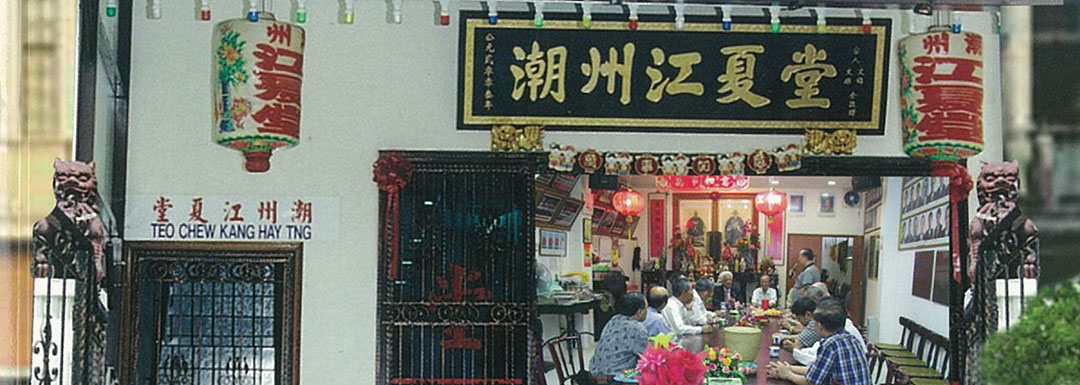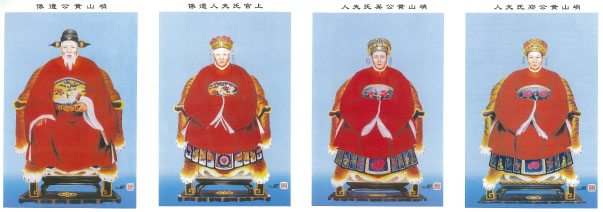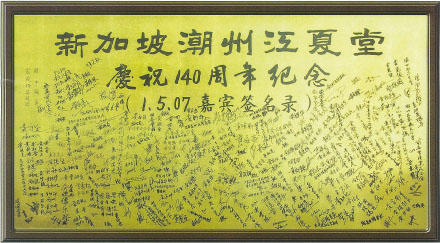 |
||||||||||||||||||
|
||||||||||||||||||

|
Chaozhou (or Teochew as we know it here) has long been known as the ‘hometown of Zou of Mencius and the hometown of Lu of Confucius’. This implies that the culture of this faraway seaside region can be comparable to Confucius’ hometown of Lu in the Spring and Autumn period. In addition, everyone is descendants of Emperor Xuanyuan, and therefore of noble origins. One of them was Huang Xiaoshan, who settled in Chaozhou and spread his roots there.
Unfortunately, during the end of the Ming Dynasty, unstable political situation resulted in chaos all over the country. People suffered under the rule of a different race and began to look overseas for alternative livelihood. Of those who ventured southward, many came from the Huang family. A group settled in Singapore and began to call this place home. Since more than a hundred years ago, there were already records that the Huang family came to Singapore. They lived, worked and procreated here, generations after generations. In order to remember their roots and honour their ancestors, and to ensure that the descendants will not forget their roots, the Huang family built a cenotaph at Taishanting (where Ngee Ann City now sits). They held ceremonial prayers during spring and winter, year after year, as a show of filial piety towards their ancestors. Many years later, some ancestors felt that they should also establish an ancestral hall besides just having a cenotaph so that those of the same roots can stay united and be in touch. As the saying goes, blood is thicker than water. After relentless efforts by Zaiquan, Kunyan, Xianzhou and many others, the Kang Hay T’ng of the Huang family was finally established in 1867. Due to lack of resources, the ancestral hall was simple and barren. In less than 20 years it began to appear dilapidated. Some parts of the wall could not take the tolls of time and began to collapse. Fortunately some warm-hearted sages like Weiting, Liqin, Qinsheng, Wenke, Yansen, Xiquan began to raise funds to rebuild the place. In less than a year, major renovation works on the premise began, and a board of directors was elected. Application for membership poured in, even from as far as West Malaysia. Subsequently, the place would be packed on days of ancestral worship, with many coming to reconnect with their roots. In 1952, the landlord decided to take back the land where the Huang cenotaph was located for residential purposes. After much deliberation, the Board of Directors, consisting of Hansan, Qinsheng, Xiquan, Xiaoen, Shitong, Deming and others, decided to raise funds to shift the cenotaph. In November 1953, the Huang cenotaph was relocated to Guangde Shan, while the Kang Hay ancestral hall, along with its ancient charm, remained at Taishanting. In 1967, the site of the ancestral hall was once again marked for redevelopment. The Board of Directors had no choice but to relocate the ancestral tablet to the Kang Hay T’ng office at Clarke Quay. In 1968, the Kang Hay T’ng office was, yet again, ordered to relocate to make way for city development. In order to ensure that the descendants of Huang Xiaoshan continue their tradition of ancestral worship, Chairman Guozhi, Secretary General Yilu, Treasurer Hanchu and all members of the Board came together to raise funds for the move, which finally happened during spring 1968 , when they found a new location at 78A Upper Serangoon Road. The official move took place on 1 May (15th day of the third lunar month) and the Huang family was able to carry on their tradition of ancestral worship. In 1982, Chairman Ziming and Secretary General Yachang proposed that they purchase a site for the ancestral hall. The proposal garnered strong support from other members, and contributions poured in. They raised a total of $228,500, and purchased a site at 7 Kim Yan Road for $210,000. They moved in on 26 December 1983. On 11 November 2001, it was found that the ancestral hall was in a bad shape, with its collapsed walls and dilapidated buildings. The site was sold for $1.6 million, and the clan bought a new place at 27 Geylang Lorong 24. $360,000 was used for renovation works, with the balance of about $200,000 left as funds for the clan after the move on 17 March 2003. It has been 140 years since the establishment of Teochew Kang Hay T’ng. The clan has gone through many ups and downs during these long years. From the election of Ziming as the chairman to Guangxing, Yachang, Ziyuan, Shousong, Hanchu, Yilu and support from other clan members, the clan managed to overcome various challenges and move forward. New members are being introduced and the younger generation being groomed to spread the work of Kang Hay T’ng. In response to the educational policies to make education available to the masses, Teochew Kang Hay T’ng established a scholarship committee in 1974. The clan hoped to encourage children of members to work hard and contribute to society.
Through the years, Teochew Kang Hay T’ng has organized numerous trips to Chaoshan for members, where they were warmly welcomed by the local people back at their hometown. The clan has also established close relationship with overseas clans in Shenzhen, Sarawak, Seberang Perai in Penang, Sibu, Bintulu and other countries, supporting one another and enhancing the unity between overseas clans. In order to meet the requirements of the modern world, we are also actively making use of new technology like the internet and mobile communication, overcoming restrictions of time, space and region and greatly enhancing the efficiency of our exchanges and sharing. Let us work hand in hand to uphold our tradition and virtues of our ancestors, strengthening the cohesiveness amongst members and creating a better future for Teochew Kang Hay T’ng. |
|
|||||||
| Site Map | Terms of Use | © Copyright Teochew Kang Hay T'ng 2014. | |||||||



